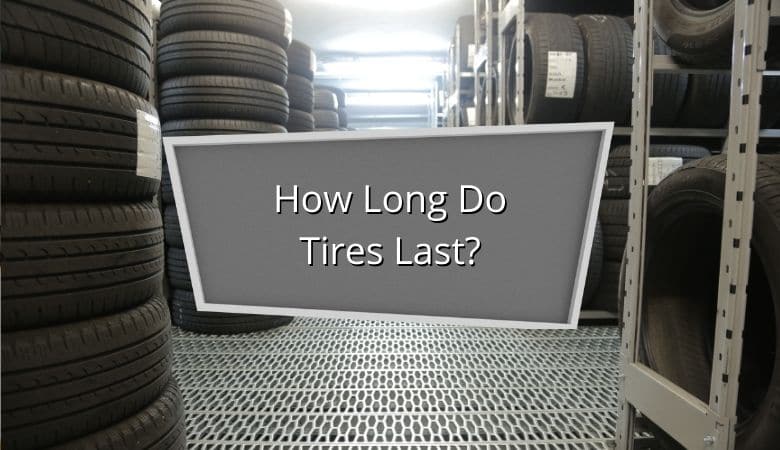Tires are one of the most important parts of your vehicle, and you should replace them once they are worn out or damaged.
Also, if you don’t plan on using your vehicle anytime soon, you have to think about the longevity of your tires without use as well. Tires can be kept in good condition for years without use if stored properly, but not all tires will maintain their integrity over time if they aren’t used properly.
So, how long do tires last? There is no official recommendation for how long tires last, but a good rule of thumb is that your tires should be replaced once they are five years old, driven for more than the manufacturers recommended mileage and/or once the tread depth reaches below 2/32 of an inch.
In this post we will look deeper into the longevity of tires and also how to make them last as long as possible.
How Long do The Different Tire Season Types Last?
On average, the different tire season types, i.e. summer, winter, all-season and all-weather, don’t last for the same duration.
Here’s how long each of them last on average:
Summer Tires: Average Lifespan
A good quality summer tire should last for about 20,000-40,000 miles, which for the average person is about two to five years. This, of course, depends on driving style, road condition, and maintenance.
Expect to change your summer tires very often, about every two years, if you live in a place where you have warm weather year-round and hence always drive around with summer tires on your car.
Conversely, if you live in a climate where you need to change between summer and winter tires, your summer tires will obviously last longer, closer to five years.
You can learn more about the longevity of summer tires specifically in our post “How Long do Summer Tires Last?“
Winter Tires: Average Lifespan
The average winter tire should last for at least 30,000 miles, which for the average person is about three to six seasons. This depends on driving style, road condition, and maintenance.
Same story here as with the summer tires, if you live in a place where the winter seasons are longer, then you will reach these 30,000 miles sooner than if you live in a place with shorter winter seasons.
You can learn more about the longevity of winter tires specifically in our post “How Long do Winter Tires Last?“
All-Season Tires: Average Lifespan
All-season tires are very durable, at least when compared to summer and winter tires, which is a big reason why many people opt for them.
A quality all-season tire should last for about 55,000-85,000 miles, which for the average person is about three to five years when used throughout the entire year.
You can learn more about the longevity of all-season tires specifically in our post “How Long do All-Season Tires Last?”
All-Weather Tires: Average Lifespan
All-weather tires are very similar to all-season tires in that they are jack of all trades.
The difference between all-weather and all-season tires is that the all-weather perform better in winter climates compared to the all-season which is mostly intended to be used during spring, summer and fall, or when temperatures are over 7 degrees C (45 degrees F).
With that said, the lifespan of all-weather tires are a bit shorter than all-season tires, and should last for about 50,000 miles on average. The reason why they have a shorter lifespan is because they are built with a softer rubber compound. This makes them perform better on snow and ice, but with the drawback of shorter tread life.
Performance Tires: Average Lifespan
Performance tires typically last for an average of 40,000 miles (64,000 kilometers). However, the actual lifespan of these tires varies depending on the type of performance tire you have on your vehicle.
Ultra-High-Performance All-Season tires tend to last around 49,000 miles, while UHP All-Summer Tires have a shorter lifespan, ranging between 15,000-30,000 miles.
You can learn more about the longevity of performance tires specifically in our post “How Long do Performance Tires Last?“
How to Find Out The Lifespan of Your Tires
The biggest factors determining how long a tire will last is age, total recommended mileage by the tire brand and tread depth.
You can check the age of your tires by reading something called the DOT code on their sidewall, the total recommended mileage by checking your tire brand mileage chart (these are usually available online), and tread depth by doing the “penny test” or by checking your tires wear bar indicators.
1. Reading The DOT Code
By law, all new car and light truck tires must carry a DOT code on their sidewall. This four-digit number tells you what kind of rubber was used to make your tire, as well as its maximum load capacity and how it was constructed.
The first two digits refer to what’s called a manufacturing week. This information shows when your tire was made. For example, 4204 means that it was manufactured in week 42 of 2004.
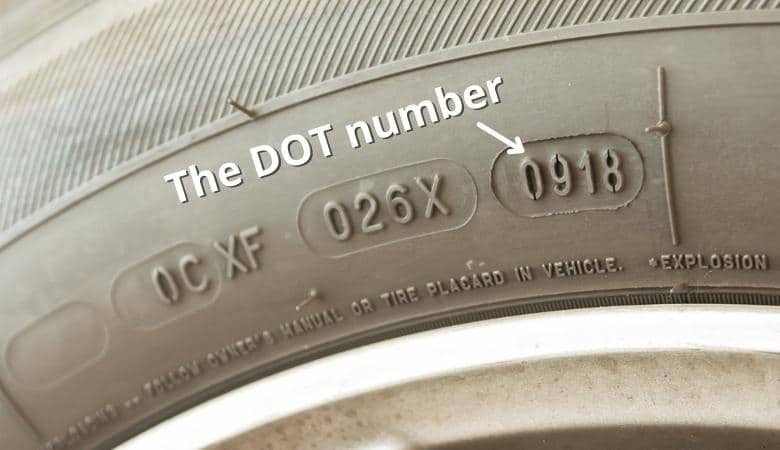
2. How to do The “Penny Test”
In the United States, tire tread depth is measured in 32nds of an inch, and safety advocates recommend that a tire should be treated as unusable when the tread depth reaches 2/32 of an inch. This can easily be measured using the famous “penny test”.
The idea of the penny test is to place a penny head pointed down between the tread ribs on your tire. If the top of the head on the penny disappears between the tread ribs, your tread is still above 2/32 of an inch. If you can still see the entire head of the penny, the tread is below 2/32 of an inch, and it’s likely time to replace the tire.
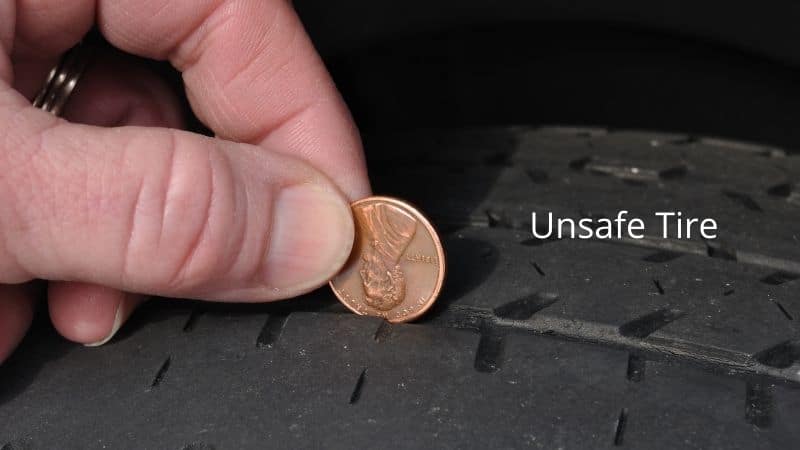
3. Checking Your Tires Wear Bar Indicators
Each and every tire sold in North America must have wear bars. Wear bars are small bars placed inside the grooves of the tires. When the tire tread reach the same level as the wear bars, the tire is no longer legal to drive on.
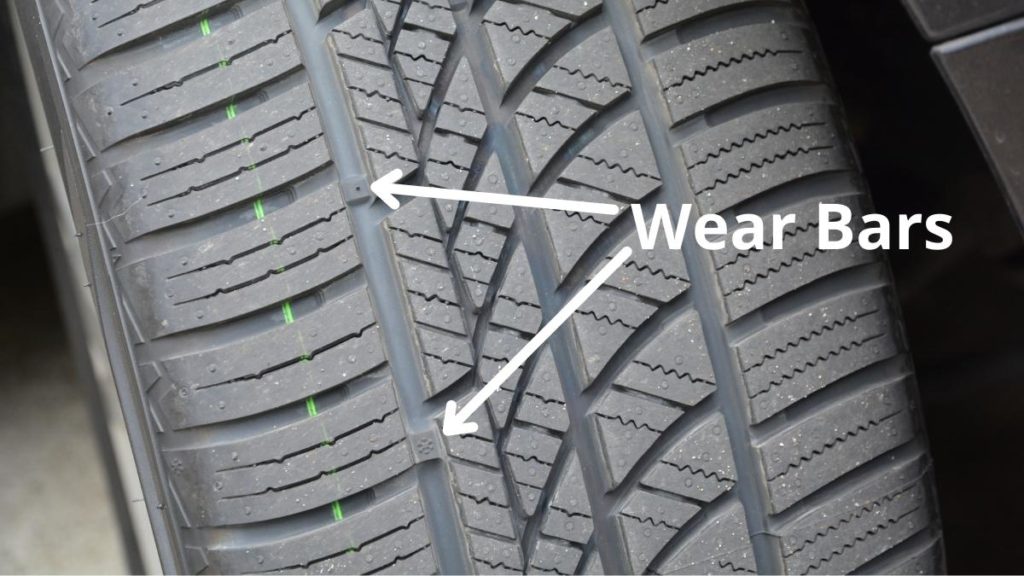
7 Things That Affects The Lifespan Of Tires (Both Used and Unused)
When we buy new tires, we like to think that they will last forever and that we’ll never have to change them again.
But the reality is that tires don’t last forever; you can extend their lifespans by taking good care of them, but if you don’t, they will become less effective over time and will be unsafe to use on the road.
Here are seven things that affect the lifespan of tires and how you can best protect your tires in order to make them last longer:
1. Temperature
Hot weather is tough on tires. In addition to breaking down faster, tires that sit in direct sunlight can quickly become a fire hazard. This is why drivers should avoid parking near fences or other objects that could cause heat damage.
Additionally, drivers should put their vehicle in the shade if parked outdoors for extended periods – especially during hot seasons like summer and early fall.
2. Tire Pressure
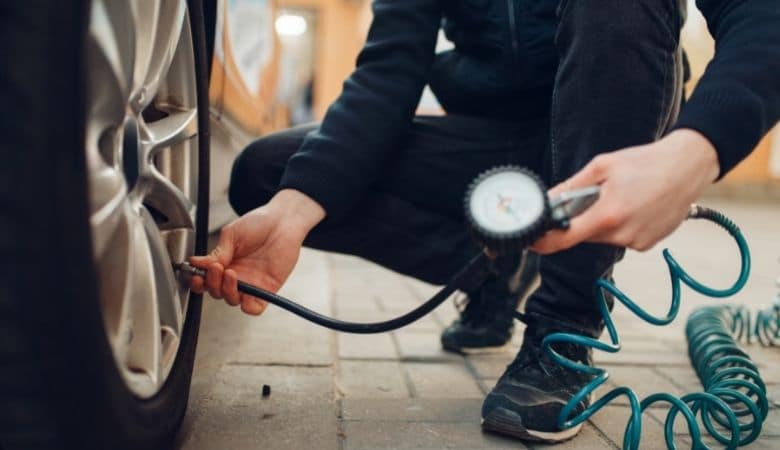
Incorrect tire pressures can affect your tires lifespan. According to Car and Driver, busting your tires recommended pressures by more than 10 percent can significantly reduce their mileage life—anywhere from 25 percent in a front tire to 55 percent in a rear. One reason is that it puts more stress on a tire when you drive with over-inflated tires.
Additionally, driving with under-inflated tires increases your chances of getting a flat. If you want to make sure you keep your tires for as long as possible, be sure to check their pressure regularly and adjust them based on what they require.
Under-inflated tires are also dangerous and unhealthy for your car’s engine, and they’re also bad news for your treads.
2. UV Rays
Since tires are made of rubber, they’re vulnerable to UV rays. This is one of their biggest enemies. So, if you’re not going to use your tires for an extended period, make sure they have some sort of UV protection.
Rubber that has been exposed to too much sunlight will lose its flexibility and could become brittle over time. As a result, when used again, these tires might be prone to cracking or tearing apart more easily on bumpy roads and in extreme weather conditions such as hail storms.
3. Moisture
Moisture is one of the tire’s biggest enemies and can damage everything, from cracking rubber to causing rot. Be sure to keep your tires stored in a cool, dry place if they aren’t on your vehicle. You don’t need an expensive commercial storage facility for that – any unheated garage will work just fine.
If you must store them outside, make sure you place them in an area where they won’t be exposed to excessive moisture and temperature changes. In general, you should avoid storing tires on concrete or asphalt; setting them on dirt and gravel is usually a good idea.
4. Cuts, Punctures and Other Damage
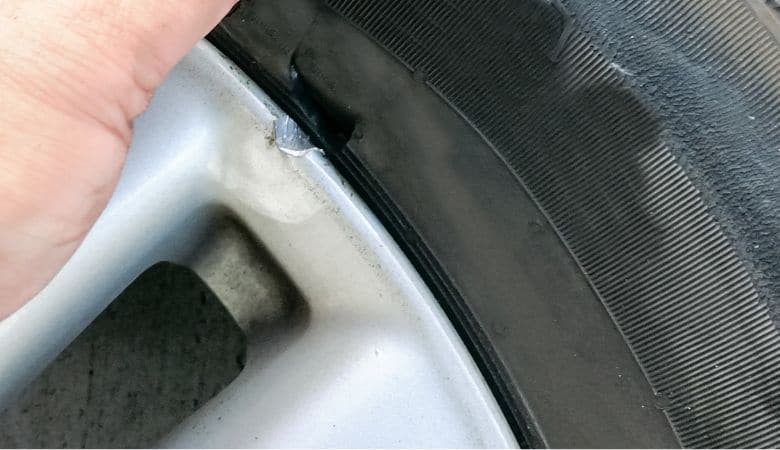
Aging tires need to be checked for cuts, punctures and other types of damage. Tiny holes or tears will get larger with time, meaning that your tire could completely blow out at any time
For example, a tiny hole can quickly turn into a 5-inch gash. Keep an eye on your tires for signs of damage and replace them as soon as you see them.
5. Vehicle Weight
Keeping your vehicle properly maintained will help extend its life and lifespan. Having a heavy car will place more stress on your tires, leading to faster wear and tear. A more efficient vehicle has a greater chance of increasing your tire’s lifespan.
If you can’t replace your vehicle for whatever reason, it’s important to keep an eye on tire pressure and weight distribution so that you can protect them from being damaged as much as possible.
6. Type of Surface Tires Are Used/Stored on
Weather is one of those things that affects tires. So, whether you live in a rainy state or snowy region, those types of weather conditions will affect your tires.
There are also other factors that can affect how long unused tires last, such as how they were stored when they were not being used.
For example, if you store them in your garage and they’re not covered up, or they are left outside under a pile of snow, then they won’t last as long because rainwater and snow can get on them and begin to deteriorate them quicker.
Weather is one thing, but where you live can play a big role, so be sure to keep these factors in mind when storing your unused tires for longer periods.
7. Driving Habits
Driving aggressively, i.e. quick accelerations, hard breakings, driving fast in courners etc., is perhaps the thing that will wear out you tires the quickest.
‘So, if you want your tires to last for as long as possible, drive calmly and with an eco-driving mindset.
How To Properly Store Tires: To Make Them Last Longer
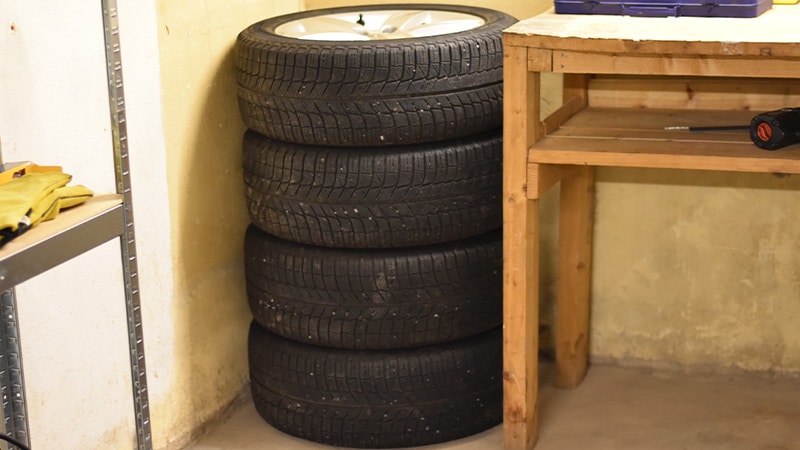
A lot of people don’t give much thought to how they store their tires. But like any other large rubber products, tires need to be properly stored if you want them to last as long as possible.
Here are a few tips on how to store tires properly, so they keep their shape and don’t crack or suffer other structural damage in the process.
1. Use The Right Type of Storage
If you’re storing your tires outside, pick a location that’s sheltered from moisture and UV rays. Your garage or shed would be good choices. If you have to keep them outside, make sure they are in a covered area with no contact with soil or water.
You may also want to consider investing in a storage building or covering your tires with an anti-UV cover if you live in a climate where sunlight is strong year-round.
After all, the worst thing for your tires is sitting outdoors for months exposed to direct sunlight and rain—they will wear down faster than if kept in ideal conditions during storage periods.
2. Store Them Away From Sharp or Harmful Items
When storing your tires, place them somewhere where you know you’ll be able to get to them. This will also help keep them in good condition when you need them again. When not in use, it’s a good idea to place your tires where you don’t have other items that might otherwise rub against or damage them.
For example, if you plan on storing a spare tire in your home, placing it in a garage or shed would probably be a good idea—especially if you have pets running around or kids playing that could harm them otherwise. Some people even choose to cut their old car tires up and utilize them as backyard mulch after they’ve worn out—it’s all up to what works best for your individual needs.
4. Protect Them Against UV Light
Tire shine is your friend—it prevents UV light from damaging your tires. Spreading a layer of tire shine over your tires will help extend their life expectancy and keep them looking good even when they’re not on your car.
Don’t forget to shine up spare tires, too! It only takes a few minutes, and it’s a great way to make sure you’re prepared for anything.
5. Keep Them In Their Original Boxes
Don’t save space by stashing your tires in a cardboard box or tossing them into an old trash bag. That won’t protect them from moisture, chemicals and other pollutants that can corrode their rubber.
As soon as you remove your tires from your car, put them back in their original packaging (keep it—you might need it again someday).
If you don’t have any boxes on hand, buy some heavy-duty plastic ones; they’re big enough to accommodate most tire sizes, and you can use them for a variety of things after storing your used ones.
6. Clean And Check For Leaks, Cracks, Holes or Damage
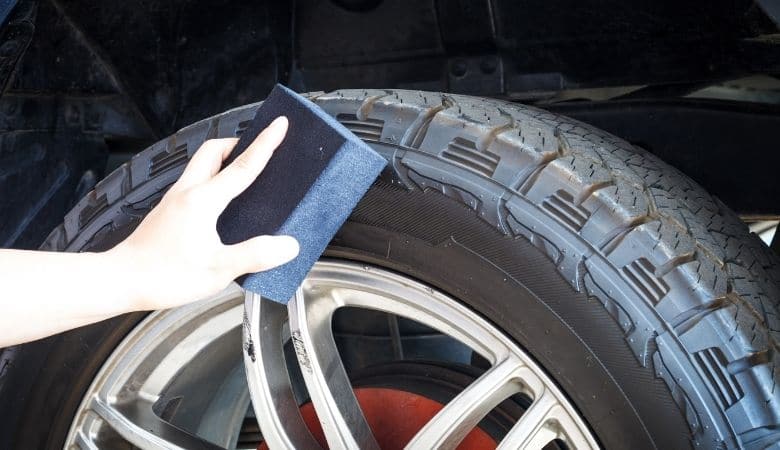
A simple visual inspection can help you avoid serious problems with your tires. Most tire stores will check and fix your tire for free. Before inspecting, let your tires cool down to a safe temperature because a hot car can lead to injury.
To examine a tire’s air pressure, check for wear and tear or damage you might not have noticed before, pull off all four of your tires and set them on something clean like concrete or hardwood flooring.
Look at each tire from all sides – making sure there are no holes or cracks in it – before moving onto one of these three important tests
7. Pre-Inflate When Packing Them in Storage
Tires can take a beating when you’re transporting them, whether it’s across town or country. To prevent them from being dented and scraped in transit, inflate them before packing them. Make sure that you have enough air in your tires so that if one of them rolls over a nail or sharp edge, you don’t end up with a flat.
8. Use a Tire Inflator
Tire pressure is a very important aspect of tire care. Low pressure in a tire can cause problems like cupping and excessive tread wear, or even flat spots.
The best way to inflate your tires is with an air compressor, but it’s not always convenient to have one of those laying around. For occasional use, you can purchase a portable air compressor; however, if you want something better for extended use, consider purchasing an electric tire inflator.
These are much more convenient since you don’t need an outlet nearby. Just be sure not to over-inflate your tires! Always double check your owner’s manual when considering inflation rates and not exceed them.
9. Get Rid Of Tires That Are Worn Out Or No Longer Needed
Old or unsafe tires don’t just pose a danger for you or other drivers—they can damage your car. When storing your old tires, make sure you dispose of them properly by taking them to a waste facility. This is especially important if your tire has been damaged and could leak air, chemicals, etc., into local waterways.
When disposing of old tires, it’s also helpful to try not to leave any in contact with rainwater because water combined with certain kinds of rubber can lead to pollution (like what happened at Minamata Bay). And remember: if a tire is worn out or has cracks, cuts, etc., it isn’t safe and should not be used under any circumstances!
Hi, my name is Niklas, the head content creator & CEO of Whirling Wheelz. I am very interested in vehicles of all kinds, mainly cars. I have a car mechanics degree from high school and a big hobby of mine is to follow the WRC (World Rally Championship) both online and through travel.

